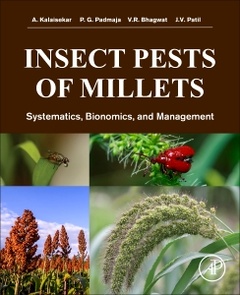Description
Insect Pests of Millets
Systematics, Bionomics, and Management
Authors: Kalaisekar A., Padmaja P. G., Bhagwat V. R., Patil J.V.
Language: English
Subject for Insect Pests of Millets:
Keywords
Anholocycly; Aphid; Aphids; Beetle; Biocontrol; Borer; Bt transgenics; Bug; Caterpillar; Cultural control; Dispersal; Evolutionary relationship; Fonio; Grasshopper; Holocycly; Host orientation; Host signaling; Host specialization; Insect pest; Insecticide; Integrated pest management; Midge; Millet production; Millet; Panicum; Pest control; Pest identification; Plant volatiles; Polymorphism; Population regulation; Quantitative trait locus; Reproductive physiology; Saprophagy; Setaria; Shoot fly; Sorghum; Tef; Termite; Thrips; Zoogeography
100.44 €
In Print (Delivery period: 14 days).
Add to cartSupport: Print on demand
Description
/li>Contents
/li>Biography
/li>Comment
/li>
Insect Pests of Millets: Systematics, Bionomics, and Management focuses on protecting the cultivated cereals that many worldwide populations depend on for food across the semi-arid tropics of the world. Providing coverage of all the major cultivated millets, including sorghum, pearlmillet, finger millet, barnyard millet, prosomillet, little millet, kodomillet, and foxtail millet, this comprehensive book on insect pests is the first of its kind that explores systematics, bionomics, distribution, damage, host range, biology, monitoring techniques, and management options, all accompanied by useful illustrations and color plates.
By exploring the novel aspects of Insect-plant relationships, including host signaling orientation, host specialization, pest ? host evolutionary relationship, and biogeography of insects and host plants, the book presents the latest ecologically sound and innovative techniques in insect pest management from a general overview of pest management to new biotechnological interventions.
1. Introduction2. Systematics and Taxonomy3. Biology, Behavior, and Ecology4. Insect–Plant Relationships5. Pest Management Strategies and Technologies
He joined ICAR-Indian Institute of Millets Research as a Scientist in 2008 and successfully handled several research projects in systematics and population biology of Shoot flies (Atherigona spp.).
Dr PG Padmaja, Principal Scientist in Agricultural Entomology at the ICAR- Indian Institute of Millets Research (formerly Directorate of Sorghum Research), Hyderabad, India. She graduated with a bachelor’s degree in Agricultural Sciences and completed her master’s in Agricultural Entomology from the Andhra Pradesh Agricultural University, Tirupathi, India. She did her Ph.D. in Entomology from the Indian Agricultural Research Institute (IARI), a premier institute of higher studies in agricultural sciences in New Delhi, India. She was awarded Rothamsted International Fellowship and did her post-doc in the Biological Chemistry, Rothamsted Research, Harpenden, UK.
She joined ICAR-Indian Institute of Millets Research as a Scientist in 1998 and successfully handled several research projects. She is interested in finding new ways to protect millets from insect pests. Her research focuses on host plant resistance mechanisms, phenotyping for shoot fly resistance and bioassay of Bt transgenic sorghum against stemborer. Presently working on devising strategies for exploiting semiochemicals for pest management in millets at the field level. Her major area of interest is to unravel the host-insect interactions by identification of novel semio-chemicals, tritrophic interactions mediated by indu
- Includes the most comprehensive and relevant aspects of insect systematics, including synonyms, nomenclatural history, and identification characters to quickly guide readers to desired information
- Addresses aspects of insect-plant relationships, including host signaling and orientation, host specialization, pest – host evolutionary relationship, and biogeography of insects and host plant
- Presents the latest research findings related to the ecological, behavioral, and physiological aspects of millet pests

